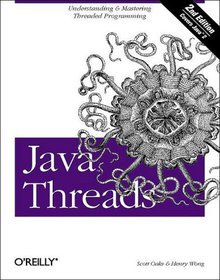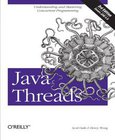Java Threads

Book Details:
| Publisher: | O'Reilly Media |
| Series: | OReilly |
| Author: | Scott Oaks |
| Edition: | 1 |
| ISBN-10: | 1565924185 |
| ISBN-13: | 9781565924185 |
| Pages: | 344 |
| Published: | Jan 27 1999 |
| Posted: | Nov 19 2014 |
| Language: | English |
| Book format: | |
| Book size: | 1.26 MB |
Book Description:
Threads aren't a new idea: many operating systems and languages support them. But despite widespread support, threads tend to be something that everyone talks about, but few use. Programming with threads has a reputation for being tricky and nonportable.Not so with Java. Java's thread facilities are easy to use, and--like everything else in Java--are completely portable between platforms. And that's a good thing, because it's impossible to write anything but the simplest applet without encountering threads. If you want to work with Java, you have to learn about threads.This new edition shows you how to take full advantage of Java's thread facilities: where to use threads to increase efficiency, how to use them effectively, and how to avoid common mistakes.Java Threads discusses problems like deadlock, race condition, and starvation in detail, helping you to write code without hidden bugs. It brings you up to date with the latest changes in the thread interface for JDK 1.2.The book offers a thorough discussion of the Thread and ThreadGroup classes, the Runnable interface, the language's synchronized operator. It explains thread scheduling ends by developing a CPUSchedule class, showing you how to implement your own scheduling policy. In addition, Java Threads shows you how to extend Java's thread primitives. Other extended examples include classes that implement reader/writer locks, general locks, locks at arbitrary scope, and asynchronous I/O. This edition also adds extensive examples on thread pools, advanced synchronization technique, like condition variables, barriers, and daemon locks. It shows how to work with classes that are not thread safe, and pays special attention to threading issues with Swing. A new chapter shows you how to write parallel code for multiprocessor machines.In short, Java Threads covers everything you need to know about threads, from the simplest animation applet to the most complex applications. If you plan to do any serious work in Java, you will find this book invaluable. Examples available online. Covers Java 2.
Book categories:
Programming , Software , Science & Mathematics , Languages & Tools , Java , Programming Languages , MathematicsDownload Link:
Related Books:
Java Threads
3rd Edition
Threads are essential to Java programming, but learning to use them effectively is a nontrivial task. This new edition of the classic Java Threads shows you how to take full advantage of Java's threading facilities and brings you up-to-date with the watershed changes in Java 2 Standard Edition version 5.0 (J2SE 5.0). It provides a thorough, step-by-step approach to threads programming.Java's threading system is simple relative to other threading systems. In earlier versions of Java, this simplicity came with tradeoffs: some of the advanced features in other threading systems were not available in Java. J2SE 5.0 changes all that: it provides a large num...
UNIX Systems Programming
Communication, Concurrency and Threads
In a nutshell, this updated UNIX classic covers everything you'll ever need for threads, TCP/IP and RPC programming-with reusable code examples that explain syntax along the way. Robbins and Robbins explain the essentials of UNIX programming, concentrating on communication, concurrency, and multithreading techniques and why, when, and how to use them. They also show how to design complex software to get the best from the UNIX operating system. Using short code snippets to illustrate how to use system calls, they also include a number of hands-on "projects" that very quickly help readers expand their skill levels. The book includes chapters on files, signals, semaphores, POSIX threads, client-server communication, and remote procedure calls....
Programming with POSIX Threads
With this practical book, you will attain a solid understanding of threads and will discover how to put this powerful mode of programming to work in real-world applications. The primary advantage of threaded programming is that it enables your applications to accomplish more than one task at the same time by using the number-crunching power of multiprocessor parallelism and by automatically exploiting I/O concurrency in your code, even on a single processor machine. The result: applications that are faster, more responsive to users, and often easier to maintain. Threaded programming is particularly well suited to network programming where it helps alleviate the bottleneck of slow network I/O. This book offers an in-depth description of the IEEE op...
2007 - 2021 © eBooks-IT.org



